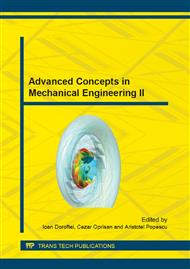p.171
p.177
p.183
p.189
p.195
p.201
p.205
p.211
p.217
Virtual High Speed Diesel Engine – A Simulated Experiment, Part II: The Influence of Polytropic Exponent upon Combustion Product Formation
Abstract:
The virtual high speed diesel engine developed by the authors focused also on combustion product formation, their prediction being possible based on detailed numerical simulation of the processes that overlap in the combustion chamber. Formation of nitrogen oxides consider extended Zeldovich mechanism and the production of combustion compounds with significant concentrations occurs in the hypothesis of excess air oxidation, being carried out according to Gartner's chemical balance. The heat input is based on distinct thermodynamic evolution characterized by constant polytropic exponents. The volume of the mixture in the combustion chamber was discretized at the level of a control micro volume, with precise initial and boundary conditions. Simulation results in the dependencies of compounds of the combustion gases according to the polytropic exponent, at a random regime. This opens the way for the study of complex influence factors which condition the polytropic exponent, upon the combustion product composition.
Info:
Periodical:
Pages:
195-200
Citation:
Online since:
October 2014
Authors:
Keywords:
Price:
Сopyright:
© 2014 Trans Tech Publications Ltd. All Rights Reserved
Share:
Citation:


